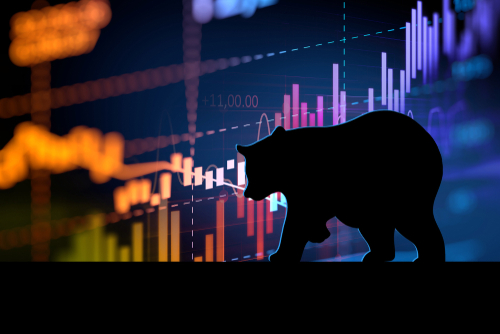ICFiles
SOC 2

Secure File Transfer Soc 2 starts at $1 per month
Have the Markets Bottomed or is it a Bear Market Rally?
Stock Market News
June, 2022
Get this Article Get this Article & Suite of Tools
Have the Markets Bottomed or is it a Bear Market Rally?
 With the S&P down nearly 20 percent and the Nasdaq index down nearly 4,000 points since the beginning of 2022, one could say the indices are in a bear market. While we can't predict the future, economic indicators can offer some insight into the likelihood of the market’s future performance.
With the S&P down nearly 20 percent and the Nasdaq index down nearly 4,000 points since the beginning of 2022, one could say the indices are in a bear market. While we can't predict the future, economic indicators can offer some insight into the likelihood of the market’s future performance.
There are many ways to determine how the market might act the next day, week or longer into the future. Looking at sectors and how they've performed against the entire market is a good way to see if it's bottomed out or if it's time to look at other sectors. Volatility and the near-term expectations are other ways to see how professional investors gauge the market's future moves. Reviewing the current and expected path of monetary policy and evolving economic indicators are still other ways to determine how markets will likely perform going forward.
The VIX and Market Capitulation
The Chicago Board Options Exchange’s (CBOE) Volatility Index (VIX) or “fear gauge” is one indicator of a market bottom. When investors attempt to hedge their investments, especially when volatility is expected, long options on the VIX can provide an “insurance policy” against falling equity prices. While there have been many levels on the VIX in the mid-30s, it often reaches levels in the 40s, 50s or even potentially higher to see a true bottom or market capitulation. Looking back to the 2008/2009 financial crisis, the VIX spiked to 79.13 on Oct. 20, 2008. Similarly, the VIX spiked to 82.69 on March 16, 2020, during the lows of the COVID-19 crash.
Measuring the Put/Call Ratio
Another indicator to gauge if the market has bottomed is when there's a large consensus of bearishness. Using the put/call ratio, investors can see the current and past ratios of puts to calls presently held in the market. As the number of puts increase relative to call options, or the number of contracts betting stocks will increase in price over time, it indicates the market movers are expecting a down-turn in the markets. As the put/call ratio rises, it implies investors are feeling more and more bearish about the markets. When the ratio hits an extreme, higher implying a market bottom and lower implying a market top, investors are signaling they are nearing a turn in the markets.
Analyzing Moving Averages
When it comes to moving averages (a 50-, 100- or 200-day, for example), it can help establish trends for stock price action. Depending on the moving average used, the lower the number of stocks above or below a particular moving day average, the sector's or index's strength and direction can be measured. When it comes to measuring an index or a sector with a moving average, if a trend is showing more stocks are declining and staying below a moving average, it gives investors a sign of bearishness. If a big percentage, such as 70 percent or 80 percent of an index or sector, is below a particular moving average, this can indicate it may be forming a bottom or oversold conditions.
The Federal Reserve and Managing Inflation
According to the Federal Reserve Bank of San Francisco, the historic range for the federal funds rate grew from 11 1/3 percent to 11 3/4 percent based on decisions from the September 1979 Federal Open Market Committee (FOMC) meeting. The Oct. 6, 1979, FOMC meeting created a four percent range for the federal funds rate (11.5 percent to 15.5 percent). By the end of 1979, the federal funds rate was nearly 14 percent, reaching 17.60 percent during 1980. Then January 1989 saw a recession due to the Fed changing reserve requirements, adding on additional fees for loans directly from the Fed, and promoting the economy to be more judicious in obtaining new loans. These changes led to interest rates rising toward the end of 1980, creating another recession in July 1980. While unemployment increased, inflation fell to four percent as 1982 closed out, compared to inflation running 14.6 percent annually between May 1979 and April 1980.
Immediately before the Oct. 6, 1979, FOMC meeting, the S&P 500 index hit a peak of 111.27 at closing the day before. Following a trend that began the Monday after the FOMC meeting, it eventually hit a “double-bottom”: 100 on Oct. 25, 1979, and then 99.87 on Nov. 7, 1979. It eventually reached a high of 118.44 on Feb. 13, 1980, before falling back to its last lows on March 27, 1980, to 98.22, and then eventually seeing an upturn.
While there are many economic, technical and fundamental indicators to gauge the direction of the stock market, taking a comprehensive approach to analyze the markets is not foolproof and risk can be mitigated only to a certain degree.
Get this Article Get this Article & Suite of Tools
These articles are intended to provide general resources for the tax and accounting needs of small businesses and individuals. Service2Client LLC is the author, but is not engaged in rendering specific legal, accounting, financial or professional advice. Service2Client LLC makes no representation that the recommendations of Service2Client LLC will achieve any result. The NSAD has not reviewed any of the Service2Client LLC content. Readers are encouraged to contact their CPA regarding the topics in these articles.
Dynamic Content Powered by Service2client.com
SEO Content Powered by DynamicPost.net






